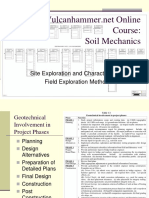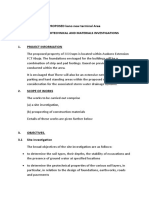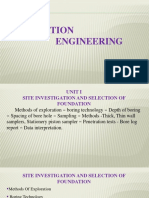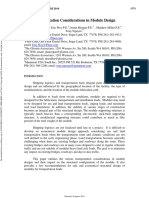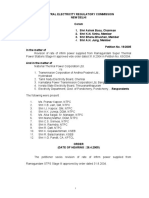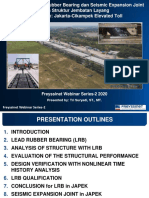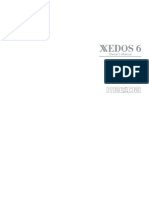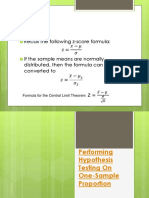CEEN3160 F10 Exploration 3pp
CEEN3160 F10 Exploration 3pp
Uploaded by
samCopyright:
Available Formats
CEEN3160 F10 Exploration 3pp
CEEN3160 F10 Exploration 3pp
Uploaded by
samOriginal Description:
Copyright
Available Formats
Share this document
Did you find this document useful?
Is this content inappropriate?
Copyright:
Available Formats
CEEN3160 F10 Exploration 3pp
CEEN3160 F10 Exploration 3pp
Uploaded by
samCopyright:
Available Formats
Subsurface Exploration
Identify Type, Depth and Location of
Underlying Soil Layers
Determine Physical Characteristics
of Soil Layers
Purpose of Subsurface
Exploration
Locate Water Table
Evaluate Load Bearing Capacity
Predict Lateral Earth Pressures
Select Type & Depth of Foundation
Estimate Settlements
Determine Potential Problems
Establish Construction Methods
Exploration Program
Collect Existing Structure
Information
Co
Collect
ect Existing
st g Subsoil
Subso Information
o at o
Reconnaissance of Proposed Site
Detailed Site Investigation
CEEN 3160 - Subsurface
Exploration 1
Existing Structure
Information
Type of Structure and Future Use
Local Building Codes
Column Loads
Load-Bearing Wall Loads
Span Length for Bridges
Pier & Abutment Loads
Existing Subsurface
Information
Geologic Survey maps (USGS)
County Soil Maps (USDA-SCS)
DOT Soils Manuals
Soil reports for nearby structures
Field Reconnaissance
Visual inspection of site and
surrounding areas
Vegetation
egetat o types
Site accessibility
Nature of surface drainage
Open cuts in nearby areas
Inspection of nearby structures
CEEN 3160 - Subsurface
Exploration 2
Detailed Site Investigation
Test borings to collect disturbed
and/or undisturbed samples for
visual and laboratory investigation
Number and depth of borings based
on project type, depth of stress
influence
Types of Borings
Auger Borings
Rotary Drilling
Wash Borings
Auger Boring
Flight Augers 60+m
Hand Augers (<10m)
CEEN 3160 - Subsurface
Exploration 3
Rotary Drilling
Rapidly rotating drilling bits attached to
bottom of drill rod
Water or drilling mud forced down rod to
bit return
bit, t flow
fl carries
i cuttings
tti to
t surface
f
Borehole from 50 to 200 mm diameter
Rotary drilling used in sand, clay and rock
Wash Borings
Common Sampling Methods
Standard Split Spoon
Standard Penetration Test (SPT)
Thin Wall Tube
Piston Sampler
CEEN 3160 - Subsurface
Exploration 4
Split Spoon Sampler
Thin Wall Tube Sampler
Piston Sampler
CEEN 3160 - Subsurface
Exploration 5
Sample Disturbance
Ar(%)=100 x (D2o-D2i) / D2i
Undisturbed if Ar < 10%
Standard Split Spoon: Ar = 110%
Shelby Tube: Ar = 13.8%
SPT Correlations
Consistency of Clays
Relative Density of Sands
Drained Friction Angle of Granular
Materials
SPT relations for Sands
Ncor Compactness Dr(%) o
0-4 V Loose 0-15 <28
4-10 Loose 15-35 28-30
10-30 Medium 35-65 30-36
30-50 Dense 65-85 36-41
>50 V Dense >85 >41
o = A + 0.15 Dr
CEEN 3160 - Subsurface
Exploration 6
SPT relations for Clays
Std Pen Consistency qu
N Of Clay kN/m2 ton/ft2
02
0-2 V Soft 0 25
0-25 0 25
0-.25
2-4 Soft ->50 ->.5
4-8 Medium ->100 ->1
8-15 Stiff ->200 ->2
15-30 V Stiff ->400 ->4
>30 Hard >400 >4
Other In Situ Tests
Vane Shear Test
Cone Penetration Test
Borehole Pressuremeter (PMT)
Dilatometer Test
Rock Coring
Recovery Ratio
Rock Quality
Designation
RQD=L4/Lt
CEEN 3160 - Subsurface
Exploration 7
RQD vs in-situ Quality
RQD Rock Quality
90 - 100 Excellent
75 - 90 Good
50 - 75 Fair
25 - 50 Poor
0 - 25 Very Poor
Boring Logs
Project ID
Thickness, location and description
of soil
o so layers
aye s
Location of water table
Sampling depths
In situ/lab test results
Driller’s notes
CEEN 3160 - Subsurface
Exploration 8
You might also like
- Geophysical Course Reservoir Geophysics Pe 22811Document44 pagesGeophysical Course Reservoir Geophysics Pe 22811Mohamad Arif IbrahimNo ratings yet
- Site InvestigationDocument17 pagesSite InvestigationNeymaRay . comNo ratings yet
- Site ExplorationDocument17 pagesSite ExplorationLEPARIYO SAMUELNo ratings yet
- Site ExplorationDocument17 pagesSite ExplorationKiprono VincentNo ratings yet
- 5 - Geotechnical Policy and Procedures ManualDocument52 pages5 - Geotechnical Policy and Procedures ManualAkmal GGeminkNo ratings yet
- 24 JuntepDocument8 pages24 JuntepMD. NASIF HOSSAIN IMONNo ratings yet
- Site Investigation and Field Tests PDFDocument51 pagesSite Investigation and Field Tests PDFMahmoud MansourNo ratings yet
- CIVIL 741 Ground Improvements Presentation 1Document31 pagesCIVIL 741 Ground Improvements Presentation 1RufaroNo ratings yet
- Surface & Subsurface Geotechnical InvestigationDocument5 pagesSurface & Subsurface Geotechnical InvestigationAshok Kumar SahaNo ratings yet
- Bearing Capacity of Shallow FoundationDocument46 pagesBearing Capacity of Shallow FoundationAnkur ChoudharyNo ratings yet
- 1 BAA3513 Site InvestigationDocument32 pages1 BAA3513 Site Investigationاحمد يوسفNo ratings yet
- Tuticorin Geotechnical ReportDocument16 pagesTuticorin Geotechnical Reportmohan890No ratings yet
- Sharif Theory Final 1Document28 pagesSharif Theory Final 1Ashraf ZamanNo ratings yet
- Formation EvaluationDocument61 pagesFormation EvaluationAntonio Abel Gonzalez CarrasquillaNo ratings yet
- CSE403 Insitu TestDocument61 pagesCSE403 Insitu Testtommyfan.workNo ratings yet
- 361 sl14Document45 pages361 sl14PabloNo ratings yet
- Geotechnical Investigations For BridgesDocument45 pagesGeotechnical Investigations For Bridgeskesharinaresh100% (2)
- Geotechnical Aspects BridgeDocument43 pagesGeotechnical Aspects BridgeSudipto PaulNo ratings yet
- 005 CH-7396.250 ReportDocument23 pages005 CH-7396.250 Reportsam09132No ratings yet
- 9 Precautions To Take While Performing Standard Penetration TestDocument6 pages9 Precautions To Take While Performing Standard Penetration TestRajesh KhadkaNo ratings yet
- Chapter 3 Geotechnical Conditions: Article 13Document28 pagesChapter 3 Geotechnical Conditions: Article 13Luis Carlos EspinozaNo ratings yet
- Mse Retaining Wall Design Considerations by Marcus Galvan, P.E. Txdot Bridge Division Geotechnical BranchDocument57 pagesMse Retaining Wall Design Considerations by Marcus Galvan, P.E. Txdot Bridge Division Geotechnical Branchkhairul4008No ratings yet
- Site Investigation and Sampling MethodsDocument71 pagesSite Investigation and Sampling MethodsChin Tiong LeeNo ratings yet
- 229 - PadurDocument14 pages229 - PadurpmrameshkumarNo ratings yet
- Standard Penetration TestDocument4 pagesStandard Penetration Test11 Sqn RERNo ratings yet
- 7.1 Formation EvaluationDocument25 pages7.1 Formation EvaluationSamuel OkezieNo ratings yet
- 12 - Mullakadu - Chainage - 138.8 Tuticorin Gas Pipe Line ProjectDocument21 pages12 - Mullakadu - Chainage - 138.8 Tuticorin Gas Pipe Line ProjectG. BalamuruganNo ratings yet
- Foundation Engineering - 1Document64 pagesFoundation Engineering - 1Naveen KumarNo ratings yet
- Soil ExplorationDocument127 pagesSoil ExplorationRakesh ReddyNo ratings yet
- ABR - BH02 LogDocument5 pagesABR - BH02 Log03335453629No ratings yet
- Soil Exploration-Sankar ChakrabartiDocument31 pagesSoil Exploration-Sankar Chakrabartiarindey0002No ratings yet
- ProfessionalDocument45 pagesProfessionalHemanth ChowdharyNo ratings yet
- Liquefaction Resistance of Gravelly SoilsDocument12 pagesLiquefaction Resistance of Gravelly SoilsLin WangNo ratings yet
- Chapter 1Document56 pagesChapter 1mdyusufafifNo ratings yet
- Geostatic (Overburden) Gradient.: Psi/ftDocument9 pagesGeostatic (Overburden) Gradient.: Psi/ftAHMED BAKR100% (1)
- LR. No. 048-DDocument50 pagesLR. No. 048-DPramodNo ratings yet
- DWE - Formation Evaluation 4969518 01Document144 pagesDWE - Formation Evaluation 4969518 01Amlk MartinezNo ratings yet
- Effect of Shaft Area On BallDocument17 pagesEffect of Shaft Area On BallHoàng HiệpNo ratings yet
- 3 Site - CharacterizationDocument143 pages3 Site - CharacterizationMarco NevesNo ratings yet
- Been 2010 CPT in Practice CPT10Document19 pagesBeen 2010 CPT in Practice CPT10samrkendallNo ratings yet
- C-80-80 PHQ SBC Report PDFDocument24 pagesC-80-80 PHQ SBC Report PDFVaghasiyaBipinNo ratings yet
- R Zendefy Ános: FebruaryDocument71 pagesR Zendefy Ános: Februaryfeten chihiNo ratings yet
- Brief For Geotechnical Investigations Maitama AbujaDocument6 pagesBrief For Geotechnical Investigations Maitama AbujaAdakole ObekaNo ratings yet
- L2-1 Well Site N MudlogDocument25 pagesL2-1 Well Site N MudlogIntanNurDaniaNo ratings yet
- Disaster ManagementDocument272 pagesDisaster ManagementJoy lordNo ratings yet
- Foundation Design RequirementsDocument18 pagesFoundation Design RequirementsDanyal AhmedNo ratings yet
- Group 10 Geological and Geophysical Investigation Presentation 20240308 135151 0000 1Document20 pagesGroup 10 Geological and Geophysical Investigation Presentation 20240308 135151 0000 1anpazNo ratings yet
- soil assignmentDocument7 pagessoil assignmentharsh sisodiaNo ratings yet
- Part-A: Sum of Core Pieces 10cm Total Drill RunDocument9 pagesPart-A: Sum of Core Pieces 10cm Total Drill RunSaineesh VinjamuriNo ratings yet
- Relationship Between The California Bearing Ratio and The UnconfiDocument17 pagesRelationship Between The California Bearing Ratio and The UnconfiAnastasia Dimas FebyantiNo ratings yet
- Soil Classification Using CPTDocument23 pagesSoil Classification Using CPTSajid IqbalNo ratings yet
- PIT PresentationDocument21 pagesPIT PresentationKrishNo ratings yet
- Geotechnical InvestigationDocument97 pagesGeotechnical InvestigationPRAMIT KUMAR SAMANTANo ratings yet
- Geology Note JKRDocument75 pagesGeology Note JKRriderfiz91No ratings yet
- Jamuni River Geotech ReportDocument58 pagesJamuni River Geotech ReportRoshan KejariwalNo ratings yet
- Wireline LoggingDocument40 pagesWireline LoggingZaky Asy'ari Rasyid100% (1)
- Lecture 03-Sub Surface Soil-ExplorationDocument50 pagesLecture 03-Sub Surface Soil-ExplorationShahid AliNo ratings yet
- Site ExplorationDocument30 pagesSite ExplorationgroldahNo ratings yet
- Rock Mass Classifcation: Prepared By:reda Saad Abd Elazeem Prepared To DR:AYMAN HAMEDDocument61 pagesRock Mass Classifcation: Prepared By:reda Saad Abd Elazeem Prepared To DR:AYMAN HAMEDmina redaNo ratings yet
- Rock Blasting: A Practical Treatise on the Means Employed in Blasting Rocks for Industrial PurposesFrom EverandRock Blasting: A Practical Treatise on the Means Employed in Blasting Rocks for Industrial PurposesNo ratings yet
- Chapter 08 Geotechnical LRFD DesignDocument21 pagesChapter 08 Geotechnical LRFD DesignsamNo ratings yet
- Telegram: BetonaraDocument45 pagesTelegram: BetonarasamNo ratings yet
- AISC Seismic Design - Module1 - IntroductionDocument107 pagesAISC Seismic Design - Module1 - IntroductionCristhian Solano BazalarNo ratings yet
- Transportation Considerations in Module Design: 1771 Structures Congress 2014 © ASCE 2014Document11 pagesTransportation Considerations in Module Design: 1771 Structures Congress 2014 © ASCE 2014samNo ratings yet
- Hilti Anchor - KWIK TZDocument2 pagesHilti Anchor - KWIK TZsamNo ratings yet
- Esr 2047Document22 pagesEsr 2047samNo ratings yet
- 90° Angle Fittings: ZN GRN ZN GRNDocument1 page90° Angle Fittings: ZN GRN ZN GRNsamNo ratings yet
- Flood CompactionDocument32 pagesFlood CompactionsamNo ratings yet
- MN DOT1995-19Document145 pagesMN DOT1995-19samNo ratings yet
- The Construction of Railway Bridges Then and Now PDFDocument51 pagesThe Construction of Railway Bridges Then and Now PDFsamNo ratings yet
- MS Thesis Newgard, JeffreyDocument135 pagesMS Thesis Newgard, JeffreysamNo ratings yet
- Understanding CNC Routers: Creating Forest Sector SolutionsDocument116 pagesUnderstanding CNC Routers: Creating Forest Sector Solutionssam100% (2)
- Ballast Quality and Breakdown During Tamping: BstractDocument16 pagesBallast Quality and Breakdown During Tamping: BstractsamNo ratings yet
- 1977-01 Pages 30-37 PDFDocument8 pages1977-01 Pages 30-37 PDFsamNo ratings yet
- Building Structural Design Thomas P. Magner, P.E. © 2011 Parametric Technology CorpDocument41 pagesBuilding Structural Design Thomas P. Magner, P.E. © 2011 Parametric Technology CorpsamNo ratings yet
- Industrial Chemicals Overview Product Brochure 01-16Document14 pagesIndustrial Chemicals Overview Product Brochure 01-16Daryl Chian100% (1)
- Pabalate-English 9 - Grade-9 - SPT-2-Q4Document4 pagesPabalate-English 9 - Grade-9 - SPT-2-Q4Andrey PabalateNo ratings yet
- DFDFDFDFDocument10 pagesDFDFDFDFkclaportNo ratings yet
- Anta AcidDocument9 pagesAnta AcidKuldeep MathurNo ratings yet
- Meros 1Document249 pagesMeros 1Δημήτρης ΠαπαδημητρίουNo ratings yet
- Wargames Foundry v0Document26 pagesWargames Foundry v0fake nameNo ratings yet
- Taj Mahal: 2 Architecture and DesignDocument13 pagesTaj Mahal: 2 Architecture and DesignPrasobh ShamohanNo ratings yet
- Cambridge International Examinations Cambridge Ordinary LevelDocument3 pagesCambridge International Examinations Cambridge Ordinary LevelAmanNo ratings yet
- Electronic Devices and Circuits - Special Diodes, BJT, Fet Encoded By: Ross Edward R. SamsonDocument3 pagesElectronic Devices and Circuits - Special Diodes, BJT, Fet Encoded By: Ross Edward R. SamsonrhedmishNo ratings yet
- The Android Malware Handbook Qian Han all chapter instant downloadDocument40 pagesThe Android Malware Handbook Qian Han all chapter instant downloadhonestooriah100% (4)
- Central Electricity Regulatory Commission New Delhi Coram 1. Shri Ashok Basu, Chairman 2. Shri K.N. Sinha, Member 3. Shri Bhanu Bhushan, MemberDocument4 pagesCentral Electricity Regulatory Commission New Delhi Coram 1. Shri Ashok Basu, Chairman 2. Shri K.N. Sinha, Member 3. Shri Bhanu Bhushan, Memberdan_geplNo ratings yet
- B Container SecurityDocument5 pagesB Container SecurityJobaerNo ratings yet
- AllenHeathGLD TrainingManualDocument4 pagesAllenHeathGLD TrainingManualPeter XuNo ratings yet
- Class 9 NotesDocument7 pagesClass 9 Notesjesi2210No ratings yet
- The Art of PrayerDocument250 pagesThe Art of Prayermarketingstpiusxpres0% (2)
- Freyssinet Webinar Series-2Document42 pagesFreyssinet Webinar Series-2Anto DestiantoNo ratings yet
- 2004 Act Blue BookDocument345 pages2004 Act Blue BookparooneyNo ratings yet
- Backlash in Cycloidal GearboxDocument3 pagesBacklash in Cycloidal GearboxShyam N NelluliNo ratings yet
- Mechanical Properties of Materials: Presentation ONDocument23 pagesMechanical Properties of Materials: Presentation ONAbhishek SinghNo ratings yet
- Shrinkage Limit TestDocument4 pagesShrinkage Limit Testnz jumaNo ratings yet
- Week6 ME130-2Document12 pagesWeek6 ME130-2Deact AccountNo ratings yet
- CT 2 Paper IEB Model AnswerDocument4 pagesCT 2 Paper IEB Model Answeryogeshdhane94No ratings yet
- TareaPractica U1 01Document5 pagesTareaPractica U1 01Bárbara Pedrosa RomeraNo ratings yet
- Electric Power Systems - Generator Sets - Cat - CaterpillarDocument1 pageElectric Power Systems - Generator Sets - Cat - CaterpillarAnd jazNo ratings yet
- VArsenoaia Lucrari RoDocument3 pagesVArsenoaia Lucrari Roobrejaangelica1979No ratings yet
- Xedos 6 ManualDocument17 pagesXedos 6 ManualsmsorinxpNo ratings yet
- The Hypothesis Testing On One-Sample ProportionDocument18 pagesThe Hypothesis Testing On One-Sample ProportionChecken Joy100% (1)
- Adhi Concrete Pavement System (Acps) Untuk AirportDocument22 pagesAdhi Concrete Pavement System (Acps) Untuk AirportStenly WanmresNo ratings yet
- Agilent 5530 Dynamic Calibrator - Update InformationDocument11 pagesAgilent 5530 Dynamic Calibrator - Update Informationcmm5477No ratings yet
- Eastern Michigan University ThesisDocument4 pagesEastern Michigan University Thesislindseycampbellerie100% (2)















